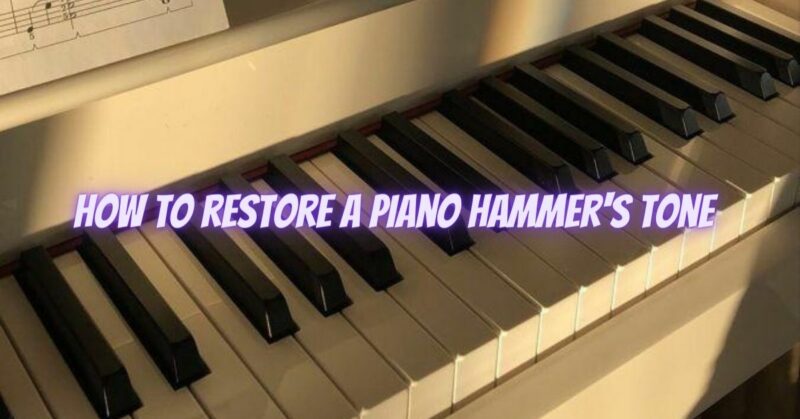The tone of a piano hammer is crucial to producing a beautiful and resonant sound. Over time, piano hammers can lose their tone due to wear and environmental factors. Restoring the tone involves a combination of voicing techniques and careful adjustments. Here’s a step-by-step guide to help you restore a piano hammer’s tone:
- Evaluate the Piano: Begin by assessing the overall condition of the piano, including the hammers. Check for visible wear, compression, or misshaping of the felt. Look for any signs of damage or aging that might affect the tone.
- Voicing: Voicing is the process of adjusting the hammer felt to achieve an even and balanced tone. It involves shaping the hammers and needling the felt to adjust its density. To voice the hammers, follow these steps:
a. Prepare the Piano: Ensure the piano is on a level surface with the keyboard cover open.
b. Gather Voicing Tools: You will need voicing needles, pliers, and other specialized voicing tools.
c. Softening or Hardening: Use voicing needles to soften or harden the hammer felt, depending on the requirements. This can be a delicate process, as too much needling can damage the felt.
d. Shaping the Hammers: Adjust the hammers’ shape by needling strategically to restore their proper curvature. This step helps ensure consistent tone across all the notes.
- Filing the Hammers (if necessary): If the hammer felt is severely compressed or misshapen, filing might be necessary. Use a hammer file to reshape the hammers gently. Be cautious not to remove too much felt, as it can alter the hammer’s weight and balance.
- Humidity Control: To maintain the restored tone, it’s essential to control the piano’s environment. Keep the humidity level between 40-50% to prevent excessive swelling or shrinking of the hammer felt. Use a hygrometer and a humidifier or dehumidifier to regulate humidity levels.
- Regular Maintenance: Perform regular maintenance and voicing sessions with a qualified piano technician. Voicing may need to be adjusted periodically as the piano hammers naturally wear down over time.
- Avoid DIY Fixes: Attempting to restore a piano hammer’s tone without proper training and tools can lead to irreparable damage. Leave complex voicing and repair tasks to experienced piano technicians.
- Seek Professional Help: If you’re unsure about restoring the piano hammer’s tone, consult a professional piano technician. They have the expertise to assess the instrument’s condition and implement appropriate restoration techniques.
- Be Patient: Restoring a piano hammer’s tone can take time and practice. Be patient during the voicing process and make gradual adjustments to achieve the desired tone.
Conclusion: Restoring a piano hammer’s tone is a delicate process that requires skill and precision. Voicing and shaping the hammers can help achieve an even and balanced tone across the keyboard. However, it’s essential to approach piano restoration with caution and avoid aggressive DIY fixes that could cause more harm than good. Regular maintenance and professional help are key to preserving the piano’s tone and ensuring it produces a beautiful and expressive sound for years to come.


